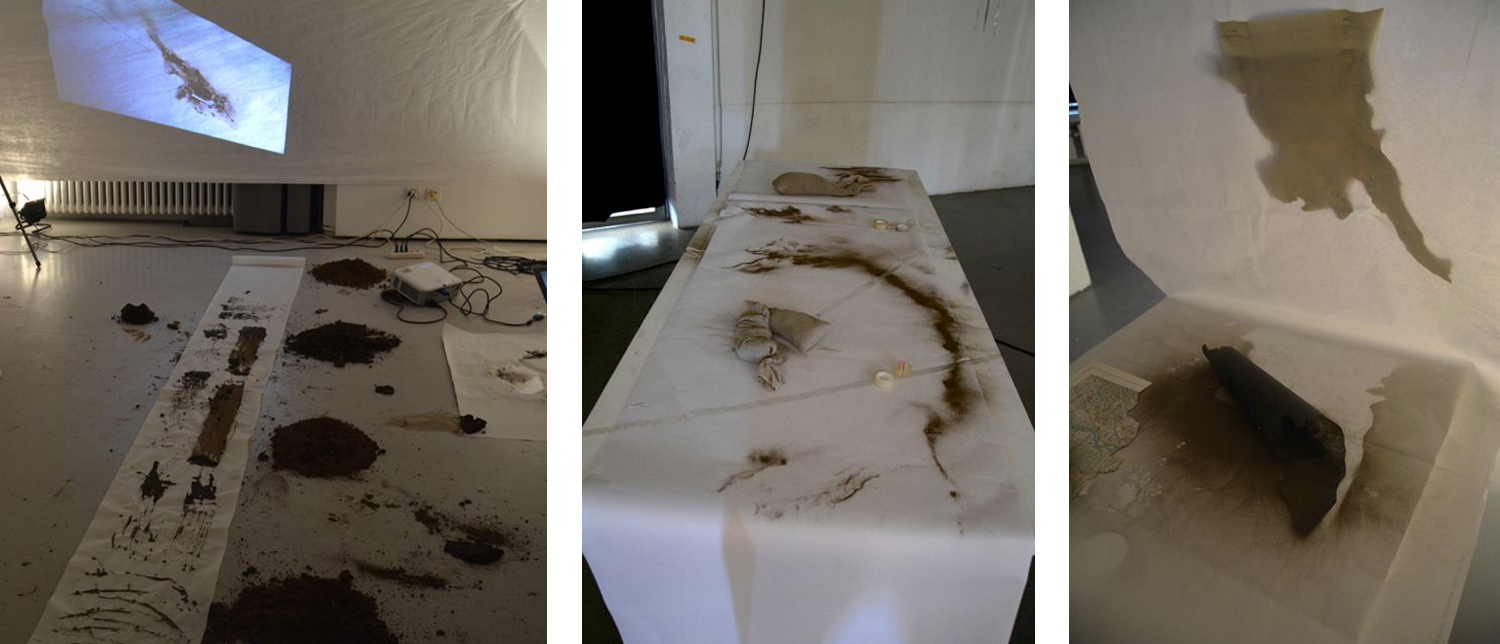Nicole De Brabandere
| Workshops | ||
As part of the research process I have activated the techniques and inscriptions generated in media and material experimentation in diverse workshop settings. The artefacts are not presented as self-contained inscriptions but openings to make felt different tensions, absorbencies, impermeabilities and textures, setting the workshop ecology into motion. These workshops open up the possibility for co-composing emergent tendencies of feeling and thinking, across corporealities, durations, media and material consistencies. The process of activating these inscriptions in workshop settings allows for analyzing how situated instances of practice mutually resonate and co-compose in a way that undermines the concept of a fully conscious, determined or contained subjectivities.
| ||
| A Collaboration of Intercessors (2014) and Tying Knots Beyond Measure (2014)
I co-developed two collaborative workshops with Amélie Brisson-Darveau, Christoph Brunner and Verena Ziegler. These are A Collaboration of Intercessors, which took place at the Adapt-r conference in Brussels (2014) and Tying
Knots Beyond Measure, which took place over the course of 24 hr. 'un-conference' Parenthesis, at
HEAD, Geneva (2014). For both workshops each collaborator introduced different textures, concepts, operations and materials that would operate as affective lures that might invite conference participants into the transversal tensions of the workshop ecology.
In A Collaboration of Intercessors I introduced sieved metallic dirt that was put into light, coarsely woven cloth bags. I designed the dirt bags so that volumes of dirt could spread in even layers over or seep between the hard edges of cut maps and sewing patterns proposed by my collaborators. In the workshop setting, the surfaces of tables, walls and floors, and the edges of maps that formerly pressed movement and attention into clearly delineated paths, began to bubble with transversal porosities
In Tying Knots Beyond Measure I introduced soil texture to activate dynamics of work-ability and the durational process when soil changes consistency between drying out and staying wet. In a state of plasticity, clay-rich soil no longer absorbs water. As a dry powder, clay-rich soil quickly absorbs water even beyond the threshold of plasticity, becoming a fluid mixture. This variability gives soil a transitional and durational quality beyond its plastic, form-taking potential.
| ||
 | ||
Inhabiting
Relief (2016)
The
workshop Inhabiting Relief (2016) took place at the Rote Fabrik in Zurich. The workshop began by introducing the concept of the Weighted Line as form that registers both direction and dimensional indeterminacy, such that it can inform choreographic improvisation. Rolls of paper were spread over the floor and a large sheet of plastic drop-sheet was hung from the wall at one end, while containers of black ink were distributed around the room. Once the materials, dimensions and participants of the workshop ecology started to co-compose, the surface of plastic began to support the flow of ink, while paper absorbed, folded and pressed against inky plastic surfaces. Over the course of the workshop, diverse operations evolved that explored emergent convergences and contrasts between flow and absorption, thinning and thickening, surface and consistency, gradation and punctuation, rhythm and pour.
| ||

| ||
|
Sticky Currents (2015)
The workshop Sticky Currents was held at the 'Affect Theory Conference' in Lancaster PA, (2015) and developed the themes of my research on Surface Tension. The workshop space was dark, except for the light projected from a video, where a membrane lifts away from lens so that light appears to peel away from the corners of the frame as it spills into the room. Participants were invited to work with the clay and the variety of surfaces that populated the workshop ecology. The workshop was also accompanied by an audio track that composed the sound of knocking on surfaces with different densities and of plastic clay as it is pounded, slapped or impacted different surfaces. These sounds were also composed with a spoken element, where words were fragmented to resonate with the process of working clay, through their referential content and onomatopoetic qualities.
Below I include a script of the spoken track where the sizes and cases of letters indicate tonal variations. This tonal emphasis allowed the spoken words to move between discursive content and sounding out the emergent surfacing of the workshop ecology.
tuNingg..........TuNing....... flAt......flaaaat----------
wrRRR~mmmmmmmmm........HOo...~
cool......cccooooo........coo~
wrRRR~mmmmmmmmm........HOo...~
tuNingg..........TuNing.......
wrRRR~mmmmmmmmm........HOo...~ | ||
| | ||
|
| ||
| | ||
| |